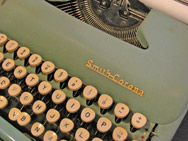Writing The Old Fashioned Way

In the not too distant past, word processors didn’t exist. In fact, computers weren’t practical machines for writing until I was out of high school (late 80’s). Up until then the only way to reliably generate a document at home was with a trusty old typewriter. It would be easy to get all misty-eyed when thinking about those halcyon days, but truth be told, composing and creating documents on a typewriter was a huge pain in the ass. All that spacing, calculating, and fiddling was maddening. And then there was the magic of erase tape. I’ve used a few typewriters in my day. My mom’s old Smith Corona warhorse served the family well for many years. I have fond memories of that machine. The clacking of the keys. The loud, mechanical sound of the built-in erase function. The smell of newly born ink. And of course, the look of freshly rendered 12pt Courier on a blank page (I still compose in double-spaced Courier – how about you?) I had my favorite machine in Typing 10 – a hulking Olivetti with some nail polish on the carriage. That machine always smelled faintly of perfume (from the girl who was in the class before me, it turned out). I could crank out close to 50 words per minute (with minimal errors) at my peak. Ah, the good old days. These days, I’m a master of the two finger hunt and peck.
It’s no understatement to say that the word processor has changed the writing process. No longer is it necessary to labour at the typewriter, vainly attempting to correct something or trying to cram revision notes in the margins. The concept and strategy of writing in drafts is challenged by the ease at which someone can move text around a screen. This is not to say that nobody writes in drafts any more. I find that I can’t properly get my head around what I’m writing until I compose a rough first draft and print it. I’m just saying that it’s very easy to edit on the fly. Almost too easy I’d say. However, I couldn’t fathom composing a long manuscript like a novel on anything but a word processor. They sure make the editing and revision process easier. Then again, you gotta admire ‘ol Kerouac for cranking out a few hundred pages on a continuous roll for days on end1.
A few months back, I picked up a new keyboard. It’s what the manufacturer calls a buckling spring model. It weighs about ten pounds and has all the feel of those old school, heavy-keyed IBM keyboards – including the almost deafening sound. This is no wimp-ass typing instrument. You could probably drop the thing from a ten-storey building and it’d be OK. I love typing on the fucker, but there’s something missing. The action is right, but the sensation isn’t quite what I’m after. I firmly believe that the physical act of writing – the tangible sensation of it – is a huge part of why people do it. There are a few interesting writing utilities / programs on the web – writer comes to mind, as does Google Docs – but none of them can replicate the sheer joy of banging out a few pages the old fashioned way.
So I bought a typewriter. A manual. A portable – 1957 vintage. No erase tape, no power return. It’s got that anachronistic “ping” when the line runs out. Not too expensive. Less than $100.00 landed cost. The idea of cranking out first drafts on this thing gets me hot. No editing. No cut and paste. Just fucking write and let the words fall where they may. It’s a fetish item to be sure, but the experience – the sensation – is delicious. Like I said, I don’t think I could compose anything of substantive length on it but it’s invaluable for shorter work.
——
1 I’m no Kerouac fanboy, but I think the guy did have his brilliant moments, and his dedication to the craft was to be admired.